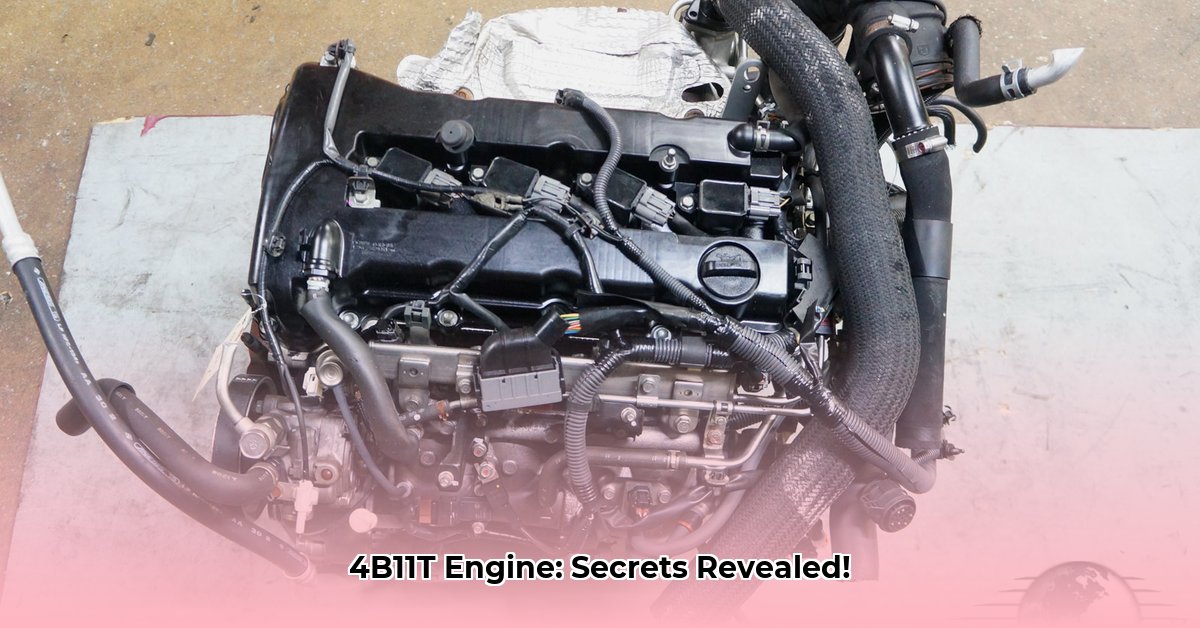
The Mitsubishi 4B11T engine—a 2.0-liter turbocharged marvel—represents a significant evolution in Mitsubishi's powerplant lineage. Replacing the iconic 4G63, this all-aluminum engine, introduced around 2007, aimed for enhanced efficiency and compliance with tightening emission regulations. However, its journey hasn't been without its bumps. This comprehensive guide explores the 4B11T's strengths, weaknesses, and strategies for maximizing its lifespan.
The 4B11T: A Blend of Innovation and Challenges
The 4B11T's design is a testament to engineering ingenuity, but it also highlights the inherent compromises often found in high-performance engines. The lightweight all-aluminum block improves handling and fuel economy, a significant advancement over its predecessor. The switch from a timing belt to a timing chain reduces the risk of catastrophic belt failure, a welcome change for reliability. Furthermore, the integration of MIVEC (Mitsubishi Innovative Valve timing Electronic Control system) variable valve timing optimizes power delivery and fuel efficiency.
However, early models (pre-2009) experienced premature timing chain stretching, leading to increased noise and potential engine instability, particularly noticeable in turbocharged variants. Additionally, reports of piston ring failure emerged, especially under high-performance driving conditions. This highlights a common tradeoff: high performance often translates to a higher risk of wear and tear.
Understanding Potential Pitfalls
The 4B11T's die-cast aluminum block with cast-iron liners presents a design challenge. While this combination balances strength and weight reduction, some experts suggest it might increase the susceptibility to piston ring failure under intense, sustained loads. This isn't unique to the 4B11T; high-performance engines frequently present this risk. Another recurring issue? Excessive engine noise, particularly during the warm-up period.
Key Features of the 4B11T
Let's delve into some defining characteristics:
- All-Aluminum Block: This lightweight design contributes to improved fuel efficiency and handling.
- MIVEC Variable Valve Timing: This sophisticated system enhances power delivery across the RPM range.
- Timing Chain: A more durable alternative to a timing belt, improving long-term reliability, although periodic inspection is still advised.
- Turbocharger: This crucial component significantly boosts the engine's power output.
Maintaining Your 4B11T: Strategies for Longevity
Proactive maintenance is paramount for this engine. Addressing timing chain issues promptly is crucial to prevent further damage. Similarly, monitoring the condition of the piston rings, especially during aggressive driving, is essential. Regular oil changes using high-quality oil specifically formulated for turbocharged engines are non-negotiable. Many enthusiasts also recommend frequent oil analysis to detect potential problems early.
4B11T vs. 4G63: A Generational Shift
The transition from the 4G63 to the 4B11T reflects a shift in design philosophy. The 4G63 focused primarily on raw power while prioritizing emission standards and efficiency. While the 4B11T offers improved low- and mid-range torque, leading to quicker acceleration, some argue it sacrifices some of the 4G63's peak horsepower and top-end power. This difference highlights how engine technology evolves to meet changing demands.
The Impact of the 4B11T: A Multifaceted Perspective
The 4B11T's impact reverberates across various stakeholders:
| Stakeholder | Short-Term Impact | Long-Term Impact |
|---|---|---|
| Mitsubishi Owners | Potential repair costs if issues arise. | Proper maintenance leads to longevity and reliability. |
| Repair Shops | Increased demand for specialized repairs and diagnostics. | Requires investment in training and specialized tools. |
| Mitsubishi (R&D) | Ongoing research and development to address reported issues. | Continuous improvement in design and manufacturing. |
The 4B11T: A Legacy in Development
The 4B11T, a technologically advanced engine, is not without its challenges. Understanding its strengths and weaknesses, coupled with diligent preventative maintenance, is crucial for maximizing its performance and longevity. While it may not match the legendary raw power of its predecessor, the 4B11T symbolizes a significant step towards increased efficiency and technological advancement. With proper care, it can deliver many years of reliable service, showcasing the ongoing evolution of automobile engineering.
Proactive Maintenance for Extended Lifespan
Key Takeaways:
- The 4B11T, while a powerful engine, has known reliability concerns.
- Understanding these weaknesses allows for proactive maintenance and extended lifespan.
- Proactive maintenance significantly reduces repair costs.
- Regular inspections and timely servicing are essential.
Addressing Common Issues
The 4B11T faces several common challenges, including excessive oil consumption, potential turbocharger failure, and carbon buildup on intake valves.
Oil Consumption: A Critical Consideration
Excessive oil consumption, often caused by worn piston rings or valve stem seals, is a frequent concern. Regular oil level checks are imperative, regularly topping off the oil as needed to prevent catastrophic damage.
Turbocharger Concerns: Ensuring Longevity
The 4B11T's turbocharger can be a point of failure. Inadequate lubrication or excessive heat can lead to premature wear. Regular inspections are crucial to address any issues promptly.
Carbon Buildup: Maintaining Performance
Direct injection engines, like the 4B11T, are susceptible to carbon buildup on intake valves. This can negatively impact performance and fuel efficiency. Regular cleaning and using high-quality fuel are vital preventative measures.
Timing Chain Considerations (Data Insufficient)
While some sources mention potential timing chain tensioner issues, further data is needed for definitive conclusions. However, regular inspection remains a prudent preventative measure.
Implementing Proactive Maintenance
A comprehensive maintenance strategy is key:
- Regular Oil Changes: Utilize the manufacturer's recommended oil type and change intervals.
- Oil Level Monitoring: Frequently check the oil level; don't wait for warning lights.
- Turbocharger Inspection: Regular visual inspections help detect potential problems early.
- Intake Valve Cleaning: Consider professional cleaning if performance diminishes.
- Timing Chain Inspection (If Feasible): Inspect the timing chain if your vehicle allows for easy access.
- Addressing Warning Signs: Address any unusual noises or performance issues immediately.
Risk Assessment: A Prioritized Approach
| Component | Failure Probability | Impact | Mitigation |
|---|---|---|---|
| Piston Rings/Valve Seals | Medium | High | Regular oil changes, prompt attention to oil consumption. |
| Turbocharger | Medium | High | Regular inspection, ensure proper oil supply and cooling. |
| Intake Valves | High | Medium | Regular cleaning, use of high-quality fuel. |
Proactive maintenance significantly extends the lifespan and reliability of your 4B11T engine. Remember, a preventative ounce truly is worth a pound of cure.